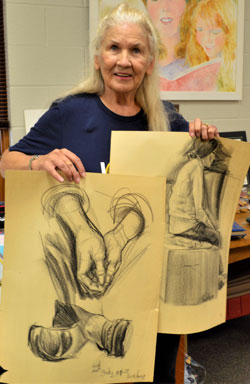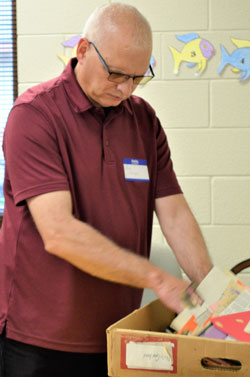Think you can wipe out memories of your your high school days – it may not be easy when a former teacher returns to your hometown with boxes of early work and stories to share.
Charlotte Ambrose, who taught art at Sparta middle and high schools for 24 years, beginning in 1964, recently did just that. A health issue prompted her to host the event, which she said was held to “remind people of their early successes.”

“Suddenly I realized that I might not live forever,” she said. “I also realized that I had abandoned artwork, which I used for samples (during art lectures) over the years, and maybe some of my students would want them.”
Rummaging through arts pieces saved since her retirement, she also found letters and numerous newspaper clippings that featured her class or awards won by her students.
She put on display a myriad of memorabilia and art pieces from former students.
As the open house guests flipped through the piles and boxes of art pieces looking for samples of their early work, their responses included surprise – “I can’t believe she kept this;” laughter – “It looks like you must have found a pretty good sale on orange paper.” – and sentimental – “Remember! We won honorable mention at that art show.”

Memories of Room 28
“I will never forget Room 28,” said Rose Russell. “There was lots of love in that room. It was the biggest confidence builder.”
“The art room was refreshing – a kind of an escape, a challenging bright spot in dry school day,” said Robert Shangel, who made a brief stop at the Ambrose open house on his way downtown for the ArtPrize 10 competition, where he competed with “The Moving Experience.”
“It really didn’t matter who you were; she treated everyone the same,” said the two-time ArtPrize finalist.
“Art was like my soul (in high school), said Joanne (Diaz) Burleson. She praised me no matter what I did.”
“She never criticized anybody,” said Lynn Clark. “We felt free to create anything, and that gave everyone a lot of courage.”
Yes, I remember, it was Room 28. I loved that room,” said Ambrose. She said that she often moved her desk around the “huge room” and vividly recalls a time it was close to the courtyard door.
“I had the door open when the boy standing next to me asked if I had ever seen a walking stick. I looked at my desk and thought he had put a stick from the yard on it. Boy did it scare me when it began to walk across the desk.”

Lasting lessons
Burleson graduated in 1971 and has spent her life since enjoying and creating art. “She really helped me cultivate my art,” said Burleson. “We learned so many different media in her class and I learned to wash a paint brush so it didn’t fall apart.”
After graduating in 1976, Jeff Okkonen headed to New York to pursue a career in music. Now living back in the area, he recalls most of all “her ability to help me see.”
“She was one of my favorite teachers. I made a point of taking her classes and had her almost every term while I was in high school,” said Okkonen. “Art class was more than a high point. I have vivid visual memories of being there.”
“She has so much enthusiasm and is so inspirational,” said former student Linda (Stevens) Longcore.
Mary (Crofoot) Foley, class of 1974, learned a lesson in compassionate discipline. “I remember when Nita (Reed) and I skipped school to go paint horses at her grandfather’s farm. It was the only time I ever skipped school and we got caught. Mrs. Ambrose told them she had sent us out to do it.”
Ambrose reflected that recent curriculum requirements can make it harder for students to participate in the arts. “As demands for more science and math came, there were less and less opportunities for students to take art. Sometimes they are forced to choose between music and art,” she said.
“Arts are a critical thing — this is so important – that students get to be themselves,” said Ambrose. “My theory is that you (as an artist) never should compare yourself to someone else. In art you learn to be an individual.”
















